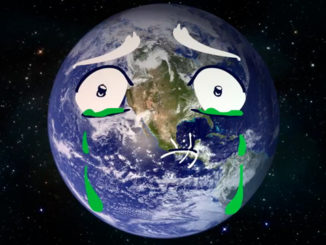
The Earth is not dying, it is being killed
by, Zaheer Astori
During the million years of journey, earth changed its landscape, climate and ecological cycle with the passage of time. These changes provoked largely by mankind.
Atmosphere consist of many layers of natural gases and different particles from the surface of earth to about 6000 km up. These gasses and particles are responsible to maintain a favorable climatic condition on the planet, the home of human beings. In the mid of 19th century, heat-trapping nature of CO2 and other gasses were demonstrated by consumption and mishandling of remnants of industrial chemicals, most of developing economies failed to dispose the remnants of hazardous chemicals. These remnants became a risk to the life on planet. Earth observatory satellites and remote sensing technologies enabled researchers to observe easily the changing in earth’s climate and landscape by many years. So, there is no confusion that increased levels of greenhouse gases must cause the Earth to warm in response. These changes are observed especially in ice core regions of polar areas and tropical mountain glaciers and in South Asia, Himalayas, Karakoram and Hindukush range’s glacial zones are melting on high scale. From 2010 to present the floods and increasing earth surface temperature are the evidences in Pakistan.
The planet’s average surface temperature has risen about 1.1 Celsius since the late 19th century, this upsurge is a result of increased carbon dioxide and other human-made emissions into natural atmosphere, naturally carbon dioxide shares 0.03% of total gases in atmosphere. As a result, every approaching year becomes warmer and 2016 was the warmest year in history. Moreover, due to such increase in surface temperature the ice bodies are losing their mass. NASA’s Gravity Recovery and Climate Experiment (NGRCE) shows that Greenland lost 150 to 250 cubic kilometers of ice per year between 2002 and 2006, while Antarctica lost about 152 cubic kilometers between 2002 to 2005.
Carbon dioxide plays a vital role in maintaining surface temperature on earth. Absorbing heat is one of the major physiognomies of CO2, due to increase in consumption of fuel, mishandling of wastage and other chemicals the amount of CO2 is increasing day by day. Due to such increase, the land surface temperature increases. As a result, the ice bodies on earth are melting and water amount in rivers and water surface in oceans are rising rapidly. From 2010 to onward Pakistan is suffering from the worst climatic changes like floods, seasonal changes, extreme changes in temperature and rainfall. The region of Gilgit-Baltistan is land of pastures and inherits major source of water in Pakistan. Most of Gilgit-Baltistan’s regions are covered by snow during winter and mountains, especially Nanga Parbat and K2 are being covered by snow during the whole year. But after these climatic changes we observed that these mountains lost the mass of snow and piedmont glaciers. After 2000 the average temperature of this region has risen and the amount of snowfall during winter is decreased. As a result, being a mountainous area, experienced a highly erosional and degradational phenomenon which badly impacts the land surface and life as well.
Urbanization is one of the major causes of affecting natural environment. Urban development disturbs the ecosystem and biodiversity of the locality. The growth of urban areas come from both the increase in migration and fertility of urban population. Firstly, urban areas are mostly covered by metaled roads and concrete buildings and secondly, the consumption patterns are much more either in food items or usage of fuel which results in sharing carbon dioxide into atmosphere.
Man exploits the natural resources to survive and such human activities impact on earth’s environment. “According to WHO, it is expected that by 2030, 6 out of every 10 people will live in a city, and by 2050, this proportion will increase to seven out of 10 people”. In many developing countries, environment impacts of urbanization like noise pollution, increasing waste emissions, air pollution, water quality and flooding, unemployment, increased crime ratio, rapidly growth in energy and resource consumption are results of the disaster. It occurs because of the lack of knowledge in dealing with issues of human activities against nature
Since the beginning of industrial revolution, the acidity of surface ocean waters has increased by about 30%. Such phenomena are a result of human emitting more carbon dioxide into atmosphere. Due to these environmental disruptions the world is facing extreme events such as during the last two years we are introduced with heat stroke especially in Karachi, in which hundreds of humans lost their life.
Climatic disruptions lead us to disasters. Disaster is a crisis situation that far exceeds the capabilities. Therefore, there is the need to plan as how to manage the growing pressure on natural resources and environment in order to improve the quality of human life would not be compromised. This realization provides an urgent need for collaboration between different systems, disciplines and cultures to provide optimal solutions to environmental challenges. We personally can help in reducing the climate change by using energy sufficient products, conserve energy at home and at work, plant trees, and the can develop the most important habit of reduce, reuse and recycle. Transportation like ride a bicycle instead of a car to reduce fossil fuel burning, reduce waste, conserve water and wastage should be disposed properly.
Environmental Management requires more systematic approach to handle than the focused methods of past. One of the emerging issues of modern world is environmental disruptions due to human activities. These disruptions have to be controlled to develop and restore a sustainable environment on the earth. To overcome such issues the importance of adopting an ecosystem approach in managing natural resource is obligatory.




